 IIA PAYEL NANDI
IIA PAYEL NANDIWarm ionized gas outflows in Active Galactic Nuclei: What causes them?
The driving force behind outflows, often invoked to understand the correlation between the supermassive black holes powering active galactic nuclei (AGN) and their host galaxy properties, remains uncertain. We provide new insights into the mechanisms that trigger warm ionized outflows in AGN, based on findings from the MaNGA survey. Our sample comprises 538 AGN with strong [O iii] λ5007 emission lines, of which 197 are detected in radio and 341 are radio-undetected. We analyzed the [O iii] λ5007 line in summed spectra, extracted over their central 500 × 500 pc2 region. The calculated Balmer 4000 Å break, Dn4000, is larger than 1.45 for ∼95% of the sources, indicating that the specific star formation rate in their central regions is less than 10−11.5 yr−1, which points to evidence of negative AGN feedback suppressing star formation. Considering the whole sample, radio-detected sources show a greater outflow detection rate (56% ± 7%) than radio-undetected sources (25% ± 3%). They also show higher velocity, mass outflow rate, outflow power, and outflow momentum rate. We noticed a strong correlation between outflow characteristics and bolometric luminosity in both samples, except that the correlation is steeper for the radio-detected sample. Our findings suggest that (a) warm ionized outflows are prevalent in all types of AGN, (b) radiation from AGN is the primary driver of these outflows, (c) radio jets are likely to play a secondary role in enhancing the gas kinematics over and above that caused by radiation, and (d) there is very little star formation in the central regions of the galaxies, possibly due to negative feedback from AGN activity.
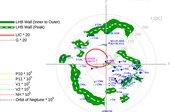 IIA JAYANT MURTHY
IIA JAYANT MURTHYThe Lyα sky as observed by New Horizons at 57 AU
During 2023 September the Alice ultraviolet spectrograph on the New Horizons (NH) spacecraft was used to map diffuse Lyα emission over most of the sky, at a range of ∼56.9 au from the Sun. At that distance, models predict that the interplanetary medium Lyα emissions result from comparable amounts of resonant backscattering of the solar Lyα line by interstellar hydrogen atoms (H i) passing through the solar system, in addition to an approximately isotropic background of ∼50 ± 20 R from the local interstellar medium (LISM). The NH observations show no strong correlations with nearby cloud structures of the LISM or with expected structures of the heliosphere, such as a hydrogen wall associated with the heliopause. To explain the relatively bright and uniform Lyα of the LISM, we propose that hot, young stars within the Local Hot Bubble shine on its interior walls, photoionizing H i atoms there. Recombination of these ions can account for the observed ∼50 R Lyα background, after amplification of the diffuse Lyα by resonant scattering, although sophisticated (i.e., 3D) radiative transfer models should be used to confirm this conjecture. Future observations of the diffuse Lyα, with instruments capable of resolving the line profile, could provide a new window on H i populations in the LISM and heliosphere. The NH Alice all-sky Lyα observations presented here may be repeated at some point in the future, if resources allow, and the two maps could be combined to provide a significant increase in angular resolution.
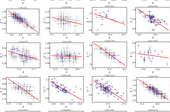 IIA STALIN, C. S
IIA STALIN, C. SThe long-term optical flux variations of Compact Symmetric Objects
Compact Symmetric Objects (CSOs) are a distinct category of jetted active galactic nuclei (AGN) whose optical variability characteristics have not been well investigated. We present here the results of our investigation on the optical flux and colour variability properties of a bona fide sample of 38 CSOs. We used the g-, r- and i-bands data from the Zwicky Transient Facility survey that spans a duration of about 5 years. We also considered a comparison sub-sample of blazars that includes 5 flat spectrum radio quasars and 12 BL Lac objects with redshifts and g-band magnitudes similar to the limited sub-sample of 9 CSOs. These two sub-samples of AGN, chosen for this comparative study of their long-term optical variability, represent different orientations of their relativistic jets with respect to the observer. We found that both CSOs and blazars exhibit optical flux variations, although variability of CSOs is lower than that of blazars. The observed variability in both CSOs and blazars is attributed to the relativistic jets and the increased optical variations in blazars relative to CSOs are likely due to beaming effects. CSOs and blazars exhibit similar colour variations, with both of them showing a bluer when brighter trend. Such a colour variability pattern is expected due to processes associated with their relativistic jets.
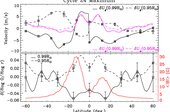 IIA RAJAGURU, S. P
IIA RAJAGURU, S. PSolar cycle variations in meridional flows and rotational shear within the sun's near-surface shear layer
Using solar cycle–long helioseismic measurements of meridional and zonal flows in the near-surface shear layer (NSSL) of the Sun, we study their spatiotemporal variations and connections to active regions. We find that near-surface inflows toward active latitudes are part of a local circulation with an outflow away from them at depths around 0.97 R⊙, which is also the location where the deviations in the radial gradient of rotation change sign. These results, together with opposite signed changes, over latitude and depth, in the above quantities observed during the solar minimum period, point to the action of the Coriolis force on large-scale flows as the primary cause of changes in rotation gradient within the NSSL. We also find that such Coriolis force mediated changes in near-surface flows toward active latitudes only marginally change the amplitude of zonal flow and hence are not likely to be its driving force. Our measurements typically achieve a high signal-to-noise ratio (>5σ) for near-surface flows but can drop to 3σ near the base (0.95 R⊙) of the NSSL. Close agreements between the depth profiles of changes in rotation gradient and in meridional flows measured from quite different global and local helioseismic techniques, respectively, show that the results are not dependent on the analysis techniques.
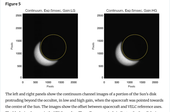 IIA RAMESH, R
IIA RAMESH, RVisible Emission Line Coronagraph (VELC) on board Aditya-L1
Aditya-L1, India’s first dedicated mission to study the Sun and its atmosphere from the Sun-Earth Lagrangian L1 location was successfully launched on September 2, 2023. It carries seven payloads. The Visible Emission Line Coronagraph (VELC) is a major payload on Aditya-L1. VELC is designed to carry out imaging and spectroscopic observations (the latter in three emission lines of the corona), simultaneously. Images of the solar corona in the continuum at 5000 Å, with a field of view (FoV) from 1.05 R to 3 R can be obtained at variable intervals depending on the data volume that can be downloaded. Spectroscopic observations of the solar corona in three emission lines, namely 5303 Å FeXIV, 7892 Å FeXI, and 10,747 Å FeXIII are possible simultaneously, with different exposure times and cadence. Four slits, each of width 50 μm, separated by 3.75 mm help to simultaneously obtain spectra at four positions in the solar corona in all the aforementioned lines. A Linear Scan Mechanism (LSM) makes it possible to scan the solar corona up to ± 1.5 R. The instrument has the facility to carry out spectropolarimetric observations at 10,747 Å also in the FoV range 1.05 – 1.5 R. Various components of the instrument were tested interferometrically on the optical bench before installation. The individual components were aligned and performance of the payload was checked in the laboratory using a laser source and tungsten lamp. Wavelength calibration of the instrument was verified using the Sun as a light source. All the detectors were calibrated for different parameters such as dark current and its variation with exposure time. Here, we discuss the various features of the VELC, alignment, calibration, performance, possible observations, initial data analysis, and results of initial tests conducted in-orbit.
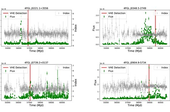 IIA AAQIB MANZOOR
IIA AAQIB MANZOORStatistical insights into flux and photon index distributions of VHE FSRQs from Fermi-LAT observations
This study examines the flux and photon index distributions of 11 Very High Energy (VHE) Flat Spectrum Radio Quasars (FSRQs) using over 16 yr of Fermi-LAT γ -ray data. The distributions reveal double lognormal profiles in both flux and index, primarily in the 3-d and 7-d binnings, supporting the ‘two-flux-state hypothesis’ for blazars. These profiles, which become insignificant at 30-d binning, suggest that shorter time-scales are better at capturing distinct states, while longer time-scales smooth out shorter variations. Most VHE FSRQs exhibit a ‘harder-when-brighter’ trend, where the photon index decreases during high-flux states, suggesting efficient particle acceleration and possibly reduced radiative cooling. In contrast, two sources display a ‘softer-when-brighter’ behaviour, likely due to enhanced radiative cooling in high photon density environments. Additionally, we observe that the Spearman rank correlation between flux and photon index strengthens with increasing time bin sizes, indicating more pronounced correlations over longer time-scales. This possibly indicates that, on shorter time-scales, flux variations are driven by a combination of photon index changes and normalization effects. Averaging flux over longer durations minimizes the effect of normalization variation, thereby enhancing the observed correlation. We also compare the flux and index distributions of VHE and non-VHE FSRQs, emphasizing the differences in their variability and emission patterns.
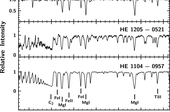 IIA ARUNA GOSWAMI
IIA ARUNA GOSWAMIHigh-resolution spectral analysis of three high-latitude carbon stars
We present the results of a detailed high-resolution spectroscopic analysis (SUBARU/HDS spectra, R ∼50,000) of three faint high-latitude carbon stars HE 1104 − 0957, HE 1205 − 0521, and HE 1244 − 3036. Our estimated metallicity for these objects is − 2.96, − 2.63, and − 2.49, respectively. The surface chemical compositions of the objects are found to be characterised by enhanced carbon and heavy elements, such as Y, Ba, La, and Ce. Using the classification criteria for carbon-enhanced metal-poor (CEMP) stars the objects HE 1104 − 0957 and HE 1205 − 0521 could not be classified into any known CEMP sub-classes, whereas the object HE 1244 − 3036 is found to be likely a CEMP-s star. The observed abundance patterns in HE 1244 − 3036 are also found to match well with the yields of a 2 M ⊙ AGB star with [Fe/H] = − 2.50. Although our kinematic analysis indicates that the objects belong to the halo population, the elemental abundance ratios of HE 1104 − 0957 and HE 1205 − 0521 do not match well with those of typical halo objects. Estimated elemental abundances are presented, and kinematic properties of the stars are discussed.
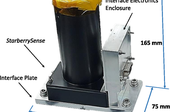 IIA BHARAT P. CHANDRA
IIA BHARAT P. CHANDRALow-cost Raspberry Pi star sensor for small satellites. II: StarberrySense flight and in-orbit performance
Star sensors are an essential instrument used to determine the attitude of satellites by identifying the stars in the field of view. The high cost and large sizes of commercially available star sensors pose challenges for small satellite missions. We at the Indian Institute of Astrophysics have developed a low-cost star sensor, StarberrySense, based on the Raspberry Pi as the main controller and built from commercial off-the-shelf components. The StarberrySense was flown on the PS4 experimental orbital platform module of the Polar Satellite Launch Vehicle C-55 by the Indian Space Research Organization. This work describes the flight hardware, environmental tests in preparation for the flight, and in-orbit performance of our StarberrySense.
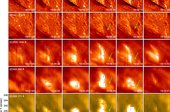 IIA TANMOY SAMANTA
IIA TANMOY SAMANTAUnveiling the Dynamics and Genesis of Small-scale Fine-structure Loops in the Lower Solar Atmosphere
Recent high-resolution solar observations have unveiled the presence of small-scale loop-like structures in the lower solar atmosphere, often referred to as unresolved fine structures, low-lying loops, and miniature hot loops. These structures undergo rapid changes within minutes, and their formation mechanism has remained elusive. In this study, we conducted a comprehensive analysis of two small loops utilizing data from the Interface Region Imaging Spectrograph (IRIS), the Goode Solar Telescope (GST) at Big Bear Solar Observatory, and the Atmospheric Imaging Assembly and the Helioseismic Magnetic Imager on board the Solar Dynamics Observatory, aiming to elucidate the underlying process behind their formation. The GST observations revealed that these loops, with lengths of ∼3.5 Mm and heights of ∼1 Mm, manifest as bright emission structures in Hα wing images, particularly prominent in the red wing. IRIS observations showcased these loops in 1330 Å slit-jaw images, with transition region (TR) and chromospheric line spectra exhibiting significant enhancement and broadening above the loops, indicative of plasmoid-mediated reconnection during their formation. Additionally, we observed upward-erupting jets above these loops across various passbands. Furthermore, differential emission measurement analysis reveals an enhanced emission measure at the location of these loops, suggesting the presence of plasma exceeding 1 MK. Based on our observations, we propose that these loops and associated jets align with the minifilament eruption model. Our findings suggest a unified mechanism governing the formation of small-scale loops and jets akin to larger-scale X-ray jets.
 IIA ARKAPRABHA SARANGI
IIA ARKAPRABHA SARANGIA Multiwavelength Autopsy of the Interacting Type IIn Supernova 2020ywx: Tracing Its Progenitor Mass-loss History for 100 Yr Before Death
While the subclass of interacting supernovae (SNe) with narrow hydrogen emission lines (Type IIn supernovae (SNe IIn)) consists of some of the longest-lasting and brightest supernovae (SNe) ever discovered, their progenitors are still not well understood. Investigating SNe IIn as they emit across the electromagnetic spectrum is the most robust way to understand the progenitor evolution before the explosion. This work presents X-ray, optical, infrared, and radio observations of the strongly interacting Type IIn supernova, SN 2020ywx, covering a period >1200 days after discovery. Through multiwavelength modeling, we find that the progenitor of 2020ywx was losing mass at ∼10−2–10−3 M⊙ yr−1 for at least 100 yr pre-explosion using the circumstellar medium (CSM) speed of 120 km s−1 measured from optical and near-infrared (NIR) spectra. Despite the similar magnitude of mass loss measured in different wavelength ranges, we find discrepancies between the X-ray and optical/radio-derived mass-loss evolution, which suggest asymmetries in the CSM. Furthermore, we find evidence for dust formation due to the combination of a growing blueshift in optical emission lines and NIR continuum emission which we fit with blackbodies at ∼1000 K. Based on the observed elevated mass loss over more than 100 yr and the configuration of the CSM inferred from the multiwavelength observations, we invoke binary interaction as the most plausible mechanism to explain the overall mass-loss evolution. SN 2020ywx is thus a case that may support the growing observational consensus that SNe IIn mass loss is explained by binary interaction.